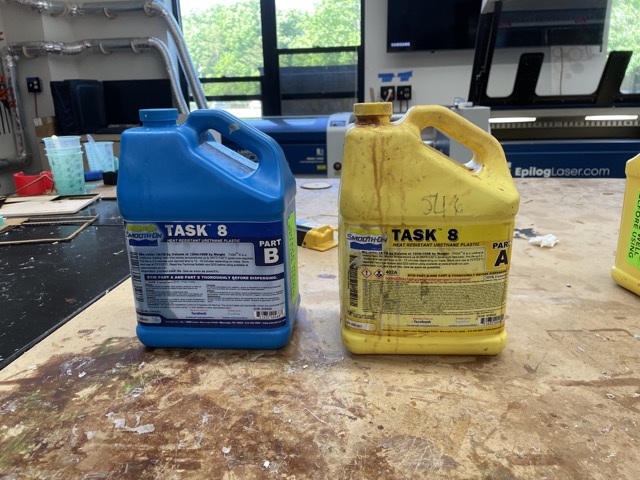12. Molding and Casting: David Vaughn and Angelina Yang¶
This week’s group assignment was to review the data sheets for the molding and casting materials we used in this week’s individual assignments, to compare them, and to compare the differences in using 3D printed vs machining molds.
Data Sheets¶
Mold Star 15 Slow¶

Key takeaways:
- 1:1 A-B mix ratio
- Pot life: 50 min
- Cure time: 4 hours
- Wear rubber gloves and safety glasses to reduce contamination
- "Green" color
- No significant shrinkage when curing
- Advisable to use a release agent so as to more easily remove mold/cast
- Do not cure at temperatures below 65F
- Curing in heated area (such as oven) can reduce curing time
Task 8¶

Key takeaways:
- 1:1 A-B mix ratio
- Pot life: 2:30 at 73F
- Color: "Off-White"
- Minimal shrinkage when curing
- 1 hour cure time at room temperature
- Higher temperature increases curing duration
Comparing Materials¶
Mold Star 15 Slow¶
During this week, we ultimately used the mold star 15 slow for both the inverse mold as well as a soft cast. To do this, we simply mixed parts A and B individually, before combining them in a 1:1 ratio.
The Mold Star 15 Slow produced a somewhat soft and quite flimsy final product, with a teal-like color. However, it is fairly durable, clean, and not very fragile, as well as relatively easy to remove from the mold.
Here is what the casts looked like:


In contrast, the Task 8 produced a hard solid that was quite different in color when originally mixed. After combining parts A and B, we noticed that the mixture immediately got thicker and warmer as it underwent an exothermic process. Overall, this casting material was harder to work with than mold star due to its comparably fast cure time–although the datasheet suggests an hour for the cure-time, I noticed that it was fully hardened in mere minutes.

Printed vs Milled¶
Of course, with both printing and milling molds, the accuracy and detail will depend on the settings you choose, and the time you are willing to spend on it. Overall, possibly just because our predisposition to it, we found 3D printing to be easier while also achieving the same level of detail. Additionally, with milling, we had to acquire, cut up, melt down, reshape, and recut pieces of wax if we wanted any significantly sized mold.
However, the wax mold did a better job at reducing stepover with the finishing pass. We could potentially limit the amount of stepover with the 3D print, but that could only happen at the expense of a longer print.